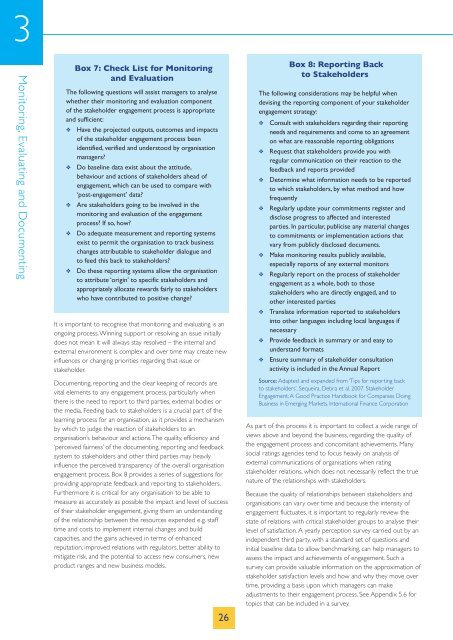Stakeholder Engagement - Cranfield School of Management ...
Stakeholder Engagement - Cranfield School of Management ...
Stakeholder Engagement - Cranfield School of Management ...
Create successful ePaper yourself
Turn your PDF publications into a flip-book with our unique Google optimized e-Paper software.
3<br />
Monitoring, Evaluating and Documenting<br />
Box 7: Check List for Monitoring<br />
and Evaluation<br />
The following questions will assist managers to analyse<br />
whether their monitoring and evaluation component<br />
<strong>of</strong> the stakeholder engagement process is appropriate<br />
and sufficient:<br />
❖ Have the projected outputs, outcomes and impacts<br />
<strong>of</strong> the stakeholder engagement process been<br />
identified, verified and understood by organisation<br />
managers?<br />
❖ Do baseline data exist about the attitude,<br />
behaviour and actions <strong>of</strong> stakeholders ahead <strong>of</strong><br />
engagement, which can be used to compare with<br />
‘post-engagement’ data?<br />
❖ Are stakeholders going to be involved in the<br />
monitoring and evaluation <strong>of</strong> the engagement<br />
process? If so, how?<br />
❖ Do adequate measurement and reporting systems<br />
exist to permit the organisation to track business<br />
changes attributable to stakeholder dialogue and<br />
to feed this back to stakeholders?<br />
❖ Do these reporting systems allow the organisation<br />
to attribute ‘origin’ to specific stakeholders and<br />
appropriately allocate rewards fairly to stakeholders<br />
who have contributed to positive change?<br />
It is important to recognise that monitoring and evaluating is an<br />
ongoing process.Winning support or resolving an issue initially<br />
does not mean it will always stay resolved – the internal and<br />
external environment is complex and over time may create new<br />
influences or changing priorities regarding that issue or<br />
stakeholder.<br />
Documenting, reporting and the clear keeping <strong>of</strong> records are<br />
vital elements to any engagement process, particularly when<br />
there is the need to report to third parties, external bodies or<br />
the media. Feeding back to stakeholders is a crucial part <strong>of</strong> the<br />
learning process for an organisation, as it provides a mechanism<br />
by which to judge the reaction <strong>of</strong> stakeholders to an<br />
organisation’s behaviour and actions.The quality, efficiency and<br />
‘perceived fairness’ <strong>of</strong> the documenting, reporting and feedback<br />
system to stakeholders and other third parties may heavily<br />
influence the perceived transparency <strong>of</strong> the overall organisation<br />
engagement process. Box 8 provides a series <strong>of</strong> suggestions for<br />
providing appropriate feedback and reporting to stakeholders.<br />
Furthermore it is critical for any organisation to be able to<br />
measure as accurately as possible the impact and level <strong>of</strong> success<br />
<strong>of</strong> their stakeholder engagement, giving them an understanding<br />
<strong>of</strong> the relationship between the resources expended e.g. staff<br />
time and costs to implement internal changes and build<br />
capacities, and the gains achieved in terms <strong>of</strong> enhanced<br />
reputation, improved relations with regulators, better ability to<br />
mitigate risk, and the potential to access new consumers, new<br />
product ranges and new business models.<br />
26<br />
Box 8: Reporting Back<br />
to <strong>Stakeholder</strong>s<br />
The following considerations may be helpful when<br />
devising the reporting component <strong>of</strong> your stakeholder<br />
engagement strategy:<br />
❖ Consult with stakeholders regarding their reporting<br />
needs and requirements and come to an agreement<br />
on what are reasonable reporting obligations<br />
❖ Request that stakeholders provide you with<br />
regular communication on their reaction to the<br />
feedback and reports provided<br />
❖ Determine what information needs to be reported<br />
to which stakeholders, by what method and how<br />
frequently<br />
❖ Regularly update your commitments register and<br />
disclose progress to affected and interested<br />
parties. In particular, publicise any material changes<br />
to commitments or implementation actions that<br />
vary from publicly disclosed documents.<br />
❖ Make monitoring results publicly available,<br />
especially reports <strong>of</strong> any external monitors<br />
❖ Regularly report on the process <strong>of</strong> stakeholder<br />
engagement as a whole, both to those<br />
stakeholders who are directly engaged, and to<br />
other interested parties<br />
❖ Translate information reported to stakeholders<br />
into other languages including local languages if<br />
necessary<br />
❖ Provide feedback in summary or and easy to<br />
understand formats<br />
❖ Ensure summary <strong>of</strong> stakeholder consultation<br />
activity is included in the Annual Report<br />
Source: Adapted and expanded from ‘Tips for reporting back<br />
to stakeholders’, Sequeira, Debra et al. 2007. <strong>Stakeholder</strong><br />
<strong>Engagement</strong>: A Good Practice Handbook for Companies Doing<br />
Business in Emerging Markets. International Finance Corporation<br />
As part <strong>of</strong> this process it is important to collect a wide range <strong>of</strong><br />
views above and beyond the business, regarding the quality <strong>of</strong><br />
the engagement process and concomitant achievements. Many<br />
social ratings agencies tend to focus heavily on analysis <strong>of</strong><br />
external communications <strong>of</strong> organisations when rating<br />
stakeholder relations, which does not necessarily reflect the true<br />
nature <strong>of</strong> the relationships with stakeholders.<br />
Because the quality <strong>of</strong> relationships between stakeholders and<br />
organisations can vary over time and because the intensity <strong>of</strong><br />
engagement fluctuates, it is important to regularly review the<br />
state <strong>of</strong> relations with critical stakeholder groups to analyse their<br />
level <strong>of</strong> satisfaction. A yearly perception survey carried out by an<br />
independent third party, with a standard set <strong>of</strong> questions and<br />
initial baseline data to allow benchmarking, can help managers to<br />
assess the impact and achievements <strong>of</strong> engagement. Such a<br />
survey can provide valuable information on the approximation <strong>of</strong><br />
stakeholder satisfaction levels and how and why they move over<br />
time, providing a basis upon which managers can make<br />
adjustments to their engagement process. See Appendix 5.6 for<br />
topics that can be included in a survey.
















